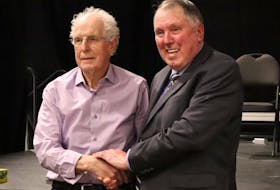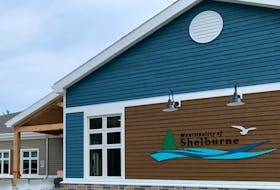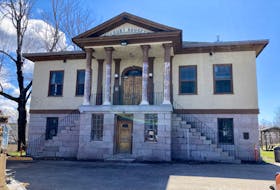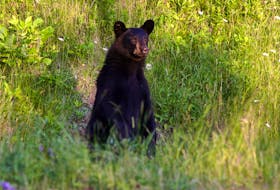HILDEN, N.S.
This is not the sort of guest most homes would welcome for a Christmas visit.
He’s rather smelly, tosses his lunch with little reason to, and tends to peck the hand that serves him.
Then again, this isn’t most homes.
The Cobequid Wildlife Rehabilitation Centre (CWRC) has taken in a black vulture, though why the rare bird is in need of the Hilden centre’s loving care remains a bit of a mystery.
It was found grounded, near Sydney.
“His body condition was great when he came in,” said Murdo Messer, co-founder of the CWRC. “He wasn’t thin and bony.”
One Dec. 15, Dr. Kathleen MacAulay, a veterinarian from Parade Street Animal Hospital, in Yarmouth, examined the bird. As a student, MacAulay spent summers working with Dr. Helene VanDonick at the CWRC and as a veterinary intern she was at The Raptor Center, in Minnesota. But this was her first time dealing with a black vulture.
“The blood test showed some lead, but not enough to cause this,” she said. “There’s nothing obvious with wings or legs, so why was this fat, feisty bird on the ground?”
X-rays were to be done within a few days.
Black vultures aren’t the easiest birds to work with. When they feel threatened, they vomit. The one at the centre did this upon being picked up. A vulture’s vomit not only smells terrible, it is so acidic it can burn enemies – having the bird pointed in the right direction is important.
The black vulture at the CWRC also put a lot of effort into trying to peck, and escape from, those handling it.
Black vultures are usually found in South America and the eastern and southern U.S., with some now seen in New England. Only about one per year is spotted in Nova Scotia.
The birds mate for life and stay with their mates year-round. They feed their young for several months and maintain strong social bonds with their families, roosting together in the evening.
The black vulture at the CWRC will remain in care for the winter.
The centre is always in need of supplies to help care for wildlife. Some of the most needed items at this time are paper towels, old sheets and pillow cases, eggs and unscented laundry soap for a front load washing machine.
Monetary donations can always be used to purchase needed items. Donations can be made online at http://cwrc.net/cms2/wp/ or can be sent to the centre at 2220 Irwin Lake Road, RR 1, Brookfield, N.S., B0N 1C0.
8 things you probably didn’t know about the black vulture
- Black Vultures will defecate on their legs and feet to cool them off.
- Adults have silvery patches on the underside of their wingtips.
- They feed mainly on carrion and will sometimes take food from landfill sites.
- They lay their eggs, which are pale green or blue, on the ground. The young are covered in yellowish or pinkish down, and have open eyes, when they hatch.
- They don’t have a voice box, but sometimes make raspy, hissing sounds when feeding or fighting, yapping sounds while courting, and pigeon-like coos when caring for their young.
- They can be 68 cm (26 in.) in length and have a wingspan of up to 150 cm (59 in).
- Turkey vultures have a better sense of smell, so black vultures will sometimes follow them to food.
- The oldest known black vulture lived to be least 25 years and six months of age.








